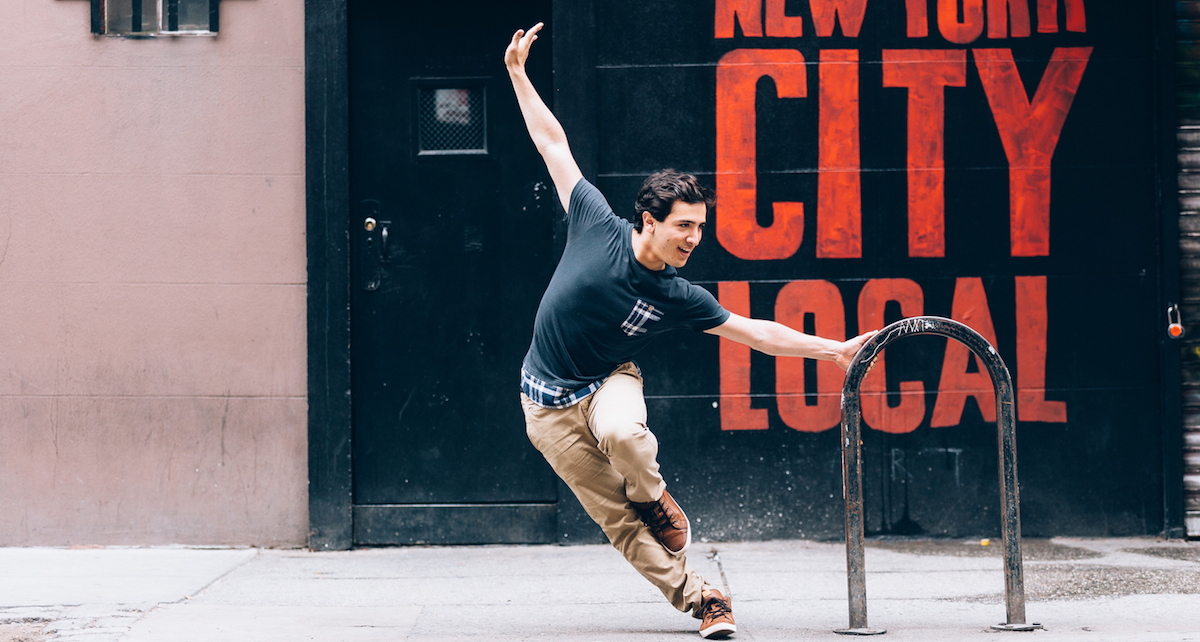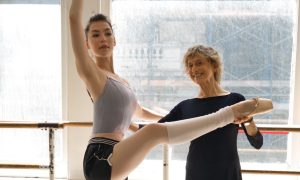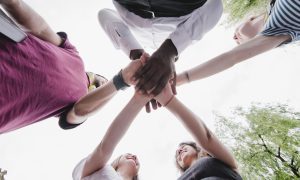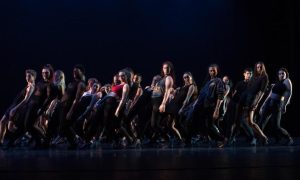“There simply is no more important investment for a working artist than excellent headshots.” That’s what Broadway Dance Center’s Director of Educational Programming, Bonnie Erickson, tells all of her dancers of BDC’s Professional Semester training program. Think a headshot is just a professional selfie? Think again! Your headshot is as — or perhaps even more — important than your resume in that it serves as a physical reminder to the creative and casting team of who you are long after you’ve auditioned in the room.
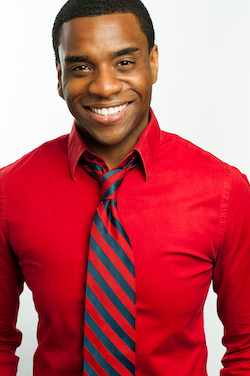
Photo by Justin Patterson.
“It is a vital tool for getting our job done properly,” explains Broadway casting director Jason Styres. “There can be so many ‘moving parts’ in an audition process, not to mention so many different people involved. Having a physical representation of you as discussions are happening is imperative. Sometimes, we have seen hundreds of people in a day and just need some help keeping our brains from becoming mush!”
After you’ve auditioned, your headshot plays a pretty big role in helping to get you the job. But don’t feel overwhelmed! Here, Dance Informa speaks with industry insiders — photographers, agents, makeup artists and casting directors — for tips to help you get the best headshots and book your next job!
Invest.
Do your research. Look into different photographers, popular makeup artists, and where to get your shots edited and printed. Ask your peers and mentors for recommendations, or check out the photo credits of dancers’ headshots that you love. You don’t necessarily need to spend hundreds of dollars, but if you want to be taken as a professional yourself, you need to invest in some professional shots.
“As a photographer,” remarks James Jin, “if my business card was handwritten on a jagged piece of paper, you probably wouldn’t take me seriously. Professional headshots are like dressing up for a job interview. It doesn’t affect your ability to do the job, but it shows that you’re serious about what you’re doing.”
Go pro.
Hire a professional hair and makeup artist. It’ll add to the expense of your headshot shoot, but it will also give you another person “on your team” to make sure your headshots look amazing.
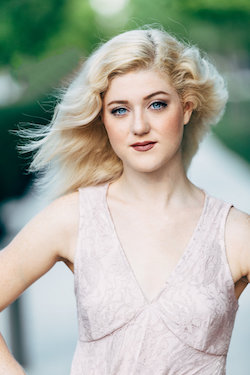
Photo by James Jin.
“The hair and makeup should definitely not be overdone,” notes agent Lucille diCampli of LDC Artist Representation. “But a professional artist (preferably one that the photographer or you have worked with before) will have the tools and techniques to know what looks best on you on camera.”
“It takes a lot of the stress and guess work out of the shoot,” adds photographer Justin Patterson. “If you are investing in yourself by getting new shots, you need to give yourself the full treatment. It’s worth it!”
Hiring a professional hair and makeup artist can cost anywhere from $75 to $300, depending on whether you’re male or female, your hair type, the number of looks you’re shooting, and if the artist will be staying on location to do touch-ups throughout your shoot. Create a Pinterest board or bring in some photos for inspiration. You can do your best to prepare yourself for your upcoming shoot by staying healthy and taking care of yourself.
“Water and sleep are essential,” says makeup artist Lynsey Buckelew. “You can also exfoliate your skin (and lips) and apply a moisturizing mask the night before for fresh, glowing skin.”
Bring a lot of options.
“When it comes to wardrobe, keep it simple,” suggests Patterson. “Your choices should be clothing that fits well and that you feel great in.”
Colors are great, but clean white, black or grey can make a stricking classic shot, too. “Your clothes should not take away the attention from your face,” notes Jin.
Stay away from crazy patterns and instead focus on interesting necklines (boat neck, v-neck, sweetheart, collared shirts, tank tops). Even if your photos are shot from the waist or shoulders up, wear a pair of comfy jeans instead of leggings or sweatpants. Belt loops and pockets give you something natural and comfortable to do with your hands.
And don’t forget to pack extra undergarments! “Ladies,” notes Buckelew, “make sure you bring a nude strapless bra and a nude thong. You never want to be stuck not getting to use an outfit because the undergarments don’t work.”
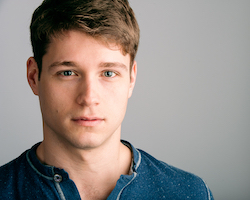
Photo by Justin Patterson.
Don’t be embarrassed to bring a suitcase full of potential outfits. It’s better to bring too many choices than not enough!
Get commercial and theatrical shots.
“A headshot has always been the artist’s calling card and first impression,” says Erickson. “But with the advent of digital media, if anything it’s gotten more important to have not just one good headshot but several showing a range of looks.”
Now, you definitely don’t need a distinct shot for every casting or audition you go to. But having both a theatrical and a commercial headshot will make you much more marketable.
“A theatrical headshot,” explains Patterson, “needs to be natural and is geared toward being cast in theatre, TV and film. You really want to show your individual personality. Commercial headshots are more geared toward advertising — your ‘type’.”
Are you the young mom or all-American boy next door? Perhaps you’re a Brooklyn hipster-type or the quirky, cute best friend. You want to imagine seeing a product or logo next to you.
“Dancers definitely need both types of shots,” advises diCampli. “When I submit a dancer, I want to use the shot that best fits that particular project.”
You want to be as versatile as possible. The more range you have, the more likely you will work!
Look like YOU!
Your headshots can be the most glamorous, photo-shopped pictures on the planet, but if you don’t look like that person in the audition room, it doesn’t matter!
“My pet peeve is when dancers or actors don’t look like their headshots,” admits Styres. “We — the casting and creative team — should be able to look at it and immediately recall you at the end of even the longest of days.”
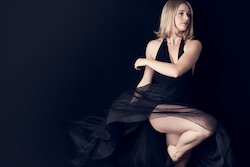
Photo by Justin Patterson.
“In a headshot session,” Jin adds, “my goal is to capture the personality and authenticity of the person in front of me. I remember going to a showcase one time and having trouble matching performers with their headshots in front of me and being surprised at how different their look was compared to what I expected from their headshots. A headshot session should not be about just getting a pretty-looking photo; it should be about capturing your real personality and charm without losing the likeness of you.”
And don’t forget that your hair color, hair length and facial hair in your headshot should still closely resemble your current look.
Print properly.
You paid for the hair, the makeup, the photo shoot and the editing. Don’t skimp on the printing! Use high-quality photo paper (“Semi-gloss is preferable and pretty affordable,” advises Styres.) in high-resolution color (black and white headshots are a thing of the past). Make sure your name is an appropriate size and printed in legible font. Like your resume, your headshot should be 8×10 inches. And don’t waste your money printing your headshot and resume double-sided. Casting directors and creatives often like to separate your headshot from your resume to have them side-by-side. Recommended printers include AdoramaPix, Reproductions and printheadshots.com.
Visit these resources for more information and for headshot samples:
Lynsey Buckelew www.lynseybuckelew.com
Lucille diCampli www.ldcartistrep.com
Bonnie Erickson www.broadwaydancecenter.com
James Jin www.jamesjinimages.com
Justin Patterson www.jpattersonphoto.com
Jason Styres www.jasonstyrescsa.com
By Mary Callahan of Dance Informa.


